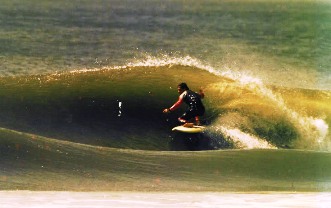Surf's Up: Wave Invites
 I wrote a bit about Google Wave last week and mentioned that I had not gotten an "invite" to play in their beta sandbox.
I wrote a bit about Google Wave last week and mentioned that I had not gotten an "invite" to play in their beta sandbox. I wasn't crowdsourcing a request, but over the weekend I have received a number of invites by email. I actually did feel some hesitation accepting any invite because I know that any new technology like this one has the potential to suck up a lot of my time.
But I did accept one (Thanks, Mary Zedeck at Seton Hall.) and we'll see what comes from it. Of course, I am hoping this particular New Jersey higher ed wave I have caught is one that will be looking for applications to our teaching.
I noticed that EDUCAUSE's latest "7 Things" document is about Wave. Right off, I am with them when they say that one downside so far is that "Despite early enthusiasm, it is not clear whether wave communication will catch on with enough people to represent a new form of communication."
About the implications for teaching and learning with Wave, they say:
Wave offers a compelling platform for personal learning environments because it provides a single location for collecting information from diverse sources while accommodating a variety of formats. By embedding mini-applications and other components, Wave makes interactive coursework a possibility for nontechnical students, moving larger numbers of students away from purely text-based assignments and into multimedia composition. Because groups can conduct real-time joint review not only of documents but also of multimedia presentations, Wave opens new avenues for critique of engineering projects, architectural designs, musical performance, or any discipline that benefits from peer or expert review. Instructors, using the playback function, could see how waves were built, step-by-step, and draw inferences about the thinking behind and evolution of student projects. Wave might also change how knowledge is created, stored, and shared. If adopted by professionals, it could provide an accessible way to model disciplinary thinking and processes with students. Whether Google Wave replaces existing applications, it likely will move communication from text alone into a wider environment more in tune with the variety of options we have come to expect from Web 2.0 technologies that enrich the human exchange of ideas.
I imagine that I will be writing again about Wave when we actually start using it in some substantial way. At first glance it feels like email stuck in an instant messaging platform, but it's much too early to know where it may lead. Perhaps, others out there in the blogosphere reading Serendipity35 will be able collaborate with us there.
When I see a good wave forming, I'll yell "Surf's up" and hopefully you can join us on the ride.
ADDITIONAL INFO
Catch the Google Wave
Riding the Google Wave
CompleteWaveGuide.com
Comments
No comments